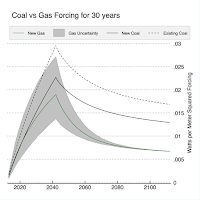The U.S. is rapidly switching from coal to natural gas for its electricity generation. Is that good news for the climate?
Just under a third of existing coal-based power generation in the United States has been shut down, and the Obama administration has aggressively embraced the replacement of coal with gas as a key part of meeting its 2030 climate targets. We are quickly traveling down a gas bridge away from coal. But will this shift actually be a good thing for the climate?
Slashing emissions at the plant
At first glance, replacing coal with natural gas seems like a good (though not great) step in combating climate change.
Overall, carbon dioxide emissions from new gas power plants are as much as 66 percent lower than those of existing coal power plants. About half of this reduction is due to differing carbon intensities of the fuels (natural gas emits 40 percent less carbon than coal per unit of heat). The other half is due to the higher generation efficiency of natural gas (new natural gas plants convert heat to power at upwards of 50 percent efficiency, while typical coal plants only operate at about 33 percent efficiency).
A way to reduce emissions by as much as two thirds while also saving money seems like a no-brainer for climate policy. But natural gas has an Achilles’ heel that makes the question much harder to answer.
Leaking Gas
...
How much methane leaks from the natural gas system is very much an open question. For a long time official Environmental Protection Agency numbers suggested the emissions were small and falling fast, only amounting to around 1.5 percent of total production.
But dozens of independent academics doing research using aircraft, satellite data, and other instruments have consistently found higher emissions than officially reported.
...
How much do leaks matter?
What do these leakage rates mean for the viability of natural gas as a bridge fuel? Again, it comes down to a question of time frame.
...
The figure at left shows the climate impacts over time (measured in units called radiative forcing) of existing coal (the dashed black line), new high-efficient coal plants (the solid black line), and new gas plants (the green line). The potential range of natural gas leakage is expressed by the gray envelope around the green line, with 1 percent leakage at the bottom and 6 percent leakage at the top (the green line itself shows a 3 percent leakage case).
If leakage is higher than 3 percent, there are some periods in the next 30 years when gas will result in more climate impact than new coal plants. If leakage is higher than 4 percent, there are some periods when gas will be worse for the climate than existing coal plants.
But no matter what the leakage rate is, gas will still cut the climate impact by 50 percent in 2100 compared to new coal and 66 percent compared to existing coal. So whether switching from coal to gas is beneficial in this simple example depends on how you value near-term or longer-term warming.
Read more at Is Natural Gas a Bridge Fuel?


No comments:
Post a Comment